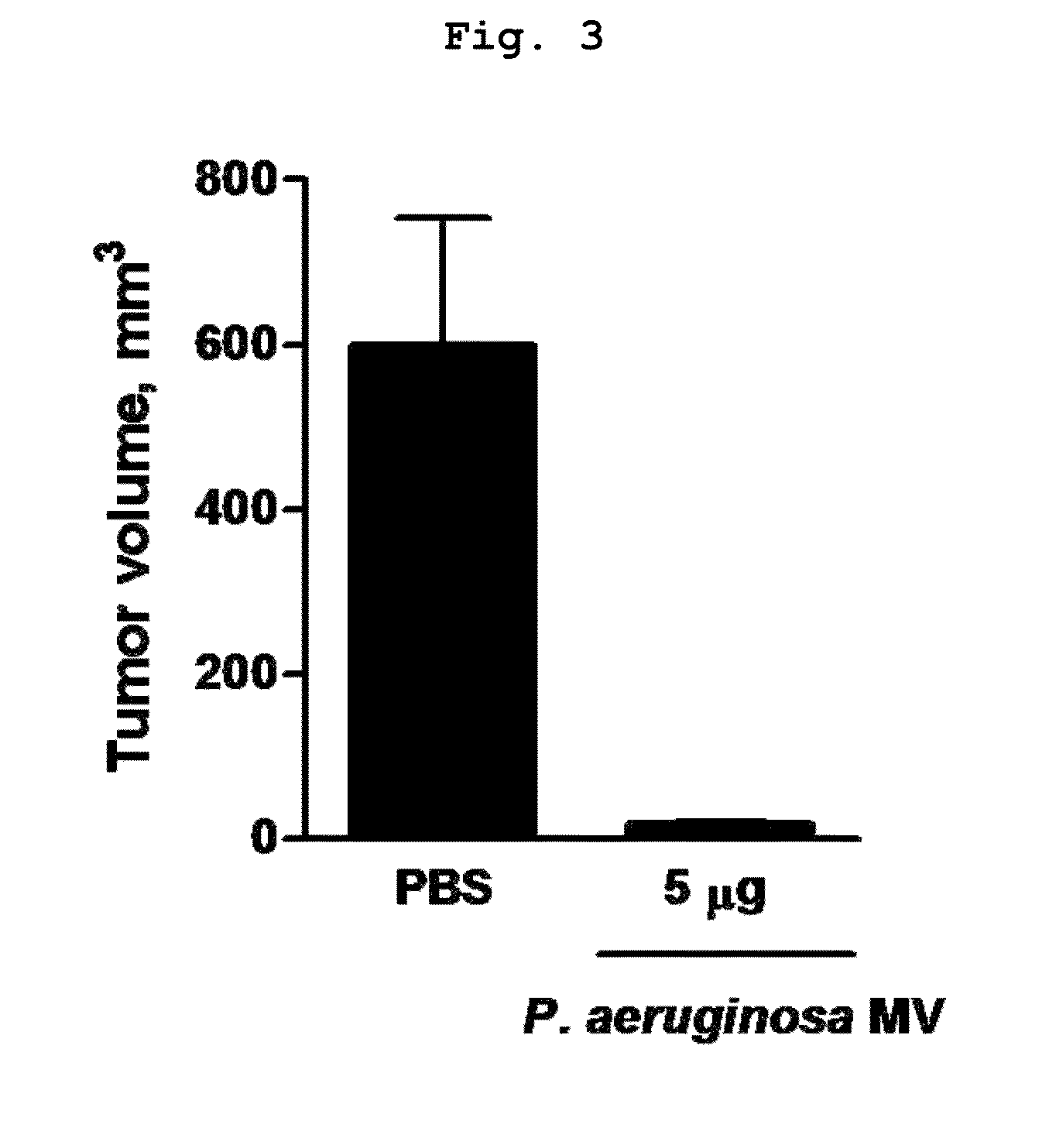Method for treating and diagnosing cancer by using cell-derived microvesicles
a cell-derived micro-vesicle and cancer technology, applied in the direction of bacteria material medical ingredients, immunological disorders, antibody medical ingredients, etc., can solve the problems of serious limitations in the capacity of these production methods, the risk of bacterial proliferation in normal tissues or organs surrounding the cancer mass, and the use of bacteria in cancer therapy. , to achieve the effect of enhancing the defense mechanism, reducing the side effects of conventional drugs, and reducing pain and inconvenience of patients in the course of treatmen
- Summary
- Abstract
- Description
- Claims
- Application Information
AI Technical Summary
Benefits of technology
Problems solved by technology
Method used
Image
Examples
example 1
Construction of Artificial Microvesicles Derived from Gram-Negative Bacteria by Extrusion and Properties Thereof
[0209]Artificial microvesicles were constructed from Gram-negative bacteria by extrusion.
[0210]In this experiment, the Gram-negative bacterium E. coli was employed. E. coli was cultured to an optical density of 1.0 (at 600 nm) in 50 mL of LB broth. The bacteria cells were collected as a pellet after centrifugation at 3,500×g for 10 min, and the cell pellet was resuspended in PBS (phosphate buffered saline).
[0211]This cell suspension was passed three times through each of membrane filters with a pore size of 10 μm, 5 μm, and 1 μm, in that order. In a 5 mL ultracentrifuge tube, 1 mL of 50% OptiPrep, 1 mL of 5% OptiPrep, and 3 mL of the cell suspension effluent from the membrane filters were sequentially placed. Ultracentrifugation at 100,000×g for 3 hrs formed a layer of microvesicles between 50% OptiPrep and 5% OptiPrep.
[0212]The artificial microvesicles constructed from th...
example 2
In Vivo Anticancer Activity of Gram-Negative Bacterial Cell-Derived Shedding Microvesicles
[0213]For use in this experiment, microvesicles that were spontaneously shed from Gram-negative bacteria were isolated. The Gram-negative bacteria E. coli, Pseudonomas aeruginosa, and Salmonella enteritidis were used as sources of microvesicles. Bacteria were inoculated into 100 mL of LB in an Erlenmeyer flask and cultured at 37° C. for 6 hrs. Of the culture, 8 mL was transferred into 600 mL of LB broth in a 2 L Erlenmeyer flask and cultured at 37° C. for 5 hrs to an optical density of 1.5 (at 600 nm). The resulting culture was divided into 500 mL high speed centrifuge tubes before centrifugation at 10,000×g and 4° C. for 20 min. The supernatant was forced to pass once through a membrane filter with a pore size of 0.45 μm, and then concentrated 25-fold using a Quixstand system equipped with a membrane having a molecular weight cut-off of 100 kDa. The concentrate was passed once through a membra...
example 3
In Vivo Anticancer Activity of Gram-Positive Bacterial Cell-Derived Shedding Microvesicles
[0216]For use in this experiment, microvesicles that were spontaneously shed from Gram-positive bacteria were isolated. The Gram-positive bacteria Staphylococcus aureus and Lactobacillus acidophilus were used as sources of microvesicles. Bacteria were inoculated into 100 mL of a nutrient broth in an Erlenmeyer flask and cultured at 37° C. for 6 hrs. Of the culture, 8 mL was transferred into 600 mL of a nutrient broth in a 2 L Erlenmeyer flask and cultured at 37° C. for 5 hrs to an optical density of 1.5 (at 600 nm). The resulting culture was divided into 500 mL high speed centrifuge tubes before centrifugation at 10,000×g and 4° C. for 20 min. The supernatant was forced to pass once through a membrane filter with a pore size of 0.45 μm, and then concentrated 25-fold using a Quixstand system equipped with a membrane having a molecular weight cut-off of 100 kDa. The concentrate was passed once th...
PUM
| Property | Measurement | Unit |
|---|---|---|
| size | aaaaa | aaaaa |
| size | aaaaa | aaaaa |
| size | aaaaa | aaaaa |
Abstract
Description
Claims
Application Information
 Login to View More
Login to View More - R&D
- Intellectual Property
- Life Sciences
- Materials
- Tech Scout
- Unparalleled Data Quality
- Higher Quality Content
- 60% Fewer Hallucinations
Browse by: Latest US Patents, China's latest patents, Technical Efficacy Thesaurus, Application Domain, Technology Topic, Popular Technical Reports.
© 2025 PatSnap. All rights reserved.Legal|Privacy policy|Modern Slavery Act Transparency Statement|Sitemap|About US| Contact US: help@patsnap.com



